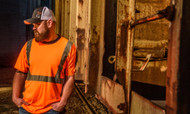4 Surprising Things You Didn’t Know About PPE
27th Feb 2023
Personal protective equipment (PPE) saves lives and lowers the risk of injury. Workers in a range of industries wear PPE to protect their eyes, heads, hearing, bodies, hands, lungs, and feet.
Creating effective safety equipment takes lots of time, effort, and thought. Discover four surprising things you didn’t know about PPE.
1. Proper Fit Is Important
A one-size-fits-all approach limits the efficacy of PPE. Fit is more crucial for some PPE than others. For example, face masks and respirators must form a seal on the face to work properly.
If your body shape changes, get a new size of PPE for proper protection. Even PPE that doesn’t require a perfect fit shouldn’t be excessively small or large. Fitted hi-vis workwear will ensure correct placement of retroreflective material.
2. PPE Is a Point-of-Contact Control
Work sites use two types of safety controls to minimize harm: pre-contact and point-of-contact controls. In pre-contact control, employers use processes including elimination, material substation, and administrative controls to remove hazards before a worker encounters them.
The second safety control type, point-of-contact control, reduces the likelihood of exposure and injury when a hazard is unremovable. PPE is the primary way to provide point-of-contact control. Workplaces should consider PPE an important last line of defense.
3. Employers Must Provide Necessary PPE and Training
Another surprising thing you might not know is that employers must provide necessary PPE and train employees on how to use it correctly. OSHA requires employers to provide PPE to employees when a hazard is present.
Employers must train employees to know when they need the equipment and what kinds are necessary. Personnel learn how to properly put on, adjust, wear, and take off the PPE. They also become familiar with the limits of the safety gear and how to maintain and dispose of it properly.
4. Two Basic Types of Retroreflective Surfaces
Although retroreflective material might look the same at first glance, there are two basic types. Glass bead reflective surfaces use microscopic glass beads to reflect light back to the source. This is the more affordable type, and it reflects light at a wider angle.
The second retroreflective surface is prismatic. Prismatic materials have manufactured prisms that are flat rather than curved and send a more focused beam of reflected light back to the light source.
Dress for work in essential safety gear from SafetyShirtz. Our selection of hi-vis safety shirts features creative designs and quality manufacturing. Shop today for the right fit and style for you.

